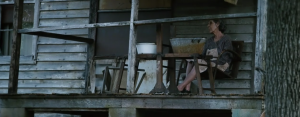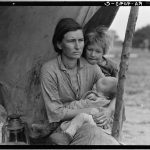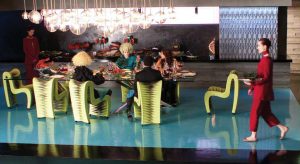Invoking the Past to Warn of the Future: Interpreting The Hunger Games’ Set Design
Panem et circenses, the Latin phrase from which Suzanne Collins borrowed to name the dystopian version of North America she created for The Hunger Games, also inspired my choices in set design. The phrase literally means “bread and circuses,” which highlights the dichotomy between the lifestyles of citizens of the lavish Capitol and their farthest neighbors, struggling against starvation in Katniss’ home district. Collins offers a potent political allegory of a totalitarian state, so I was wary of the potential for the audience to recognize that this dystopia may not be so different from our world as it may seem on paper. I wanted the audience to create an immediate connection between familiar history and the story through the juxtaposition of the gritty lifestyle of District 12 and extravagant Capitol life. I sought to emulate both the literal starvation and starvation for political aid of Depression-era Hoovervilles, “bread,” and the ridiculous excess celebrated by 60s and early 70s mod subculture, “circuses,” in my set design for the adaptation of the Hunger Games.

A woman in the Seam.

Migrant Mother. Dorothea Lange. 1936. Library of Congress.

Dwellers in Circleville’s “Hooverville,” central Ohio. Ben Shahn. Library of Congress.
Manohla Largis for The New York Times correctly interpreted Katniss’ neighborhood as inhabited by “withered Dorothea Lange types.” I wanted the weariness and the desperation Lange captured to be dripping from every aspect of each shot, not just the costuming or the actors’ expressions. For me, the novel’s vivid descriptions of the pervasive starvation, “Meat is meat…No one in the Seam would turn up their nose at a good leg of wild dog” were immediately reminiscent of the Great Depression (Collins 9). I loved the way Collins described the rugged nature of the Everdeen home. I hoped to preserve the “rough canvas cover of the mattress,” and the “vermin” that mangy Buttercup scares away so that their desperation permeated the neighborhood and the district (5). Appalachia already has an uncultivated, almost neglected atmosphere. I capitalized on that by leaning into the desolate economic sphere which begat the need to fashion homegrown solutions or leave the neighborhood to decay. I drew on the hand-built, Hooverville-style shanty homes. In the novel, electricity is unreliable in District 12, so I focused on the power of oil lanterns and plenty of natural light. The rugged, natural aesthetic of District 12 would be heavily juxtaposed by the Capitol’s artificial atmosphere.
The train served as the literal and figurative transition between the two spaces. I wanted the furniture to replicate the shift from the ramshackle District 12 to the calculated, synthetic Capitol. I achieved this by combining natural materials, such as the mahogany dining table, with mod furniture inspiration. I kept the color scheme to a rich blue, more cobalt to District 12’s slate, to ease the shift from the muted district life to the exuberant, glowing Capitol. Even the dishes are all in a style that would have been familiar to those more fortunate in the 1930s, but have clean lines to match the clean, curved edges of the train’s windows. The blend of antique touches and chrome finishes meld the two styles together seamlessly while alluding to the mod style that prevails in the Capitol.

Peeta, Katniss, and Haymitch en route to the Capitol.
For the Capitol, I was inspired by the mod subculture’s rejection of political turmoil by indulging in excess. Socio-political tensions were high due to the cultural shifts spurred by civil rights movements of the 60s and the Watergate scandal of the early 70s. Totalitarian abuse of political power to control citizens motivates the entire plot of The Hunger Games, so I thought it pertinent to draw from this era. Mod subculture revolted from the tensions of politics through immersion in excess and the strange, relative to prior trends. The Capitol apartment provided to the tributes borrows the fluorescent colors, rich fabrics, and geometric patterns of the era. There is a shift from natural to synthetic materials. The dining chairs, for example, are made of plastics in a wonderful shade of chartreuse. Everything the tributes encounter here would be considered absurd in their home because each piece of furniture and décor was designed simply to engage the eye rather than to serve any practical function. The delicate fleet of glass bulbs suspended over the equally breakable table would have no place in District 12 due to the careless waste of two valuable commodities: glass and electricity.

Effie, Katniss, and her stylists dine in the Capitol.
Ultimately, I wanted the spaces that the tributes inhabited to be visually reminiscent of politically turbulent eras in American history to foreshadow the revolution that Katniss, the Girl on Fire, is about to ignite.
Works Cited:
Collins, Suzanne. The Hunger Games. NY, NY: Scholastic, 2008. Print.
Dargis, Manohla. “Tested by a Picturesque Dystopia.” The New York Times. The New York Times Company, 22 Mar. 2012. Web. 8 Feb. 2017.
Lange, Dorothea. Destitute Pea Pickers in California. Mother of Seven Children. Age Thirty-two. Nipomo, California. 1936. Library of Congress, Washington, D.C.
Shahn, Ben. Dwellers in Circleville’s “Hooverville,” Central Ohio. 1938. Library of Congress, Washington, D.C.
“The 1960s.” History.com. A&E Television Networks, 2010. Web. 08 Feb. 2017.
The Hunger Games. Dir. Gary Ross. Perf. Jennifer Lawrence and Josh Hutcherson. Lionsgate Films, 2012. Film.
Niara,
A strength of your post is the discussion of the inspirations for the settings. I did not know about mod subculture and Dorethea Lange and I would’ve definitely not made the connection between those and the settings in the Hunger Games. I think something work on is the connection between the Latin saying and its connection to Hunger Games. I wasn’t quite able to follow along with the connection between “bread and circuses” and the districts and the capitol. I think something very interesting to think about is how the use of mod subculture, which was used in the 60’s and 70’s to revolt against political turmoil, is used by the capitol, the main source of political turmoil and government oppression in Panem. Is the use of this subculture to represent the people of the capitol attempt to forget about the oppression of the government? Or maybe forget the rebellion of the districts?
Hey Niara!
Wow your post is extremely rich in analyzation and content! I never made the connection between District 12 and the Depression-era Hoovervilles, so I was very intrigued to read about that. This great connection you made provided a fresh, new insight that many may not have noticed, so great job!
One thing to work on would be maybe taking that last sentence of your post and incorporating it somewhere earlier, perhaps as your thesis. It would have initially made your post a bit easier to follow, and you could perhaps have built upon the last part of that sentence by diving more into how it foreshadows the revolution Katniss is about to ignite.
My question for you is would you use this dichotomy in set design in the next movie? Or would you try to focus more on a different set design juxtaposition to portray a different message?
Hey! I was just looking through the list of posts and noticed that you don’t have a featured image set. I don’t want you to get marked off for something as small as that, especially because your post is rich with deep analysis and clever political associations. Not really a comment, more so just a heads up!
Pingback: sex games gamejolt